
by Larry Williams | Aug 4, 2014
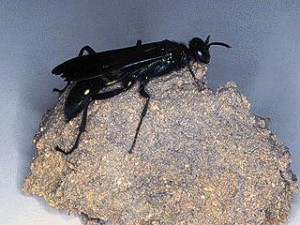
Mud dauber, Photo Credit: UF/IFAS Extension
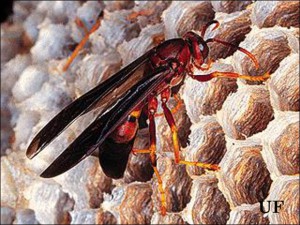
Paper wasp, Photo Credit: UF/IFAS Extension
I respect the fact that wasps can sting when threatened or disturbed. But I also respect the fact that they are beneficial.
Every time I’ve been stung by wasps, I either accidentally disturbed a nest that I didn’t know was there or I intentionally disturbed the nest and paid the price.
Paper wasps are common in Florida. They frequently construct and attach their paper-like nests to building eaves or the ceilings of porches. The adults seek out caterpillars, which they sting and paralyze. They then take the caterpillars back to their nest and place them in individual cells as food for the developing larvae.
I’ve witnessed the paper wasp as it stings and carries away a caterpillar from my vegetable garden. They are busy insects and are doing us gardeners a favor by reducing the population of caterpillars in our landscapes and gardens.
There are other beneficial wasps in Florida. Mud daubers, for example, build their mud-like nests on the sides of buildings close to human activity.
The mud dauber is not as aggressive as the paper wasp. It rarely stings people. It stings and paralyzes spiders. The mud dauber lays an egg on each paralyzed spider and seals it inside a chamber in its earthen nest. Upon hatching, the wasp larva feeds on the body of the spider. An emergence hole is made as the young wasp leaves the mud nest.
It may not be wise to tolerate all wasp species living in close proximity to your home. Even though yellow jackets, a type of wasp, could be considered beneficial, they are too aggressive and too likely to repeatedly sting to have as close neighbors. I also would be concerned with any type of wasp or bee nest existing in close proximity to individuals with a known allergy to insect stings.
Just because an insect has the ability to sting, it’s not all bad. Wasps can serve a beneficial purpose. But you’ll have to decide for yourself how close to you they can build their nests. The front porch may be too close.
by Larry Williams | Jul 15, 2014
Florida Betony (Stachys floridana), commonly called rattlesnake weed, is a Florida native plant. It’s thought to have been confined to Florida until it was moved to other Southeastern states during the 1940s or 1950s in nursery containers. It is now found from Texas to North Carolina. Its square stems are characteristic of the mint family of which it is a member.
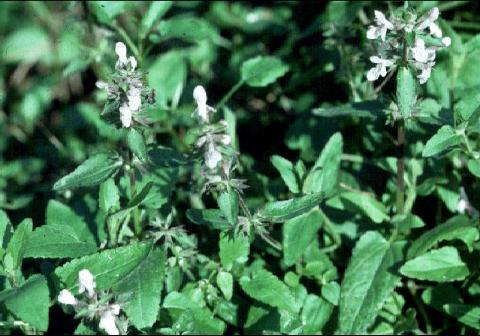
Florida Betony foliage & flowers Photo Credits: UF/IFAS Extension
Underground white, fleshy tubers, which resemble a rattlesnake’s rattle in shape, provide the main means of reproduction. Pinkish-purple flowers are followed by a dried fruit that splits open releasing tiny seeds, which are a lesser means of reproduction. The white tubers have been used for hundreds of years as a starchy vegetable and are sometimes boiled like peanuts.
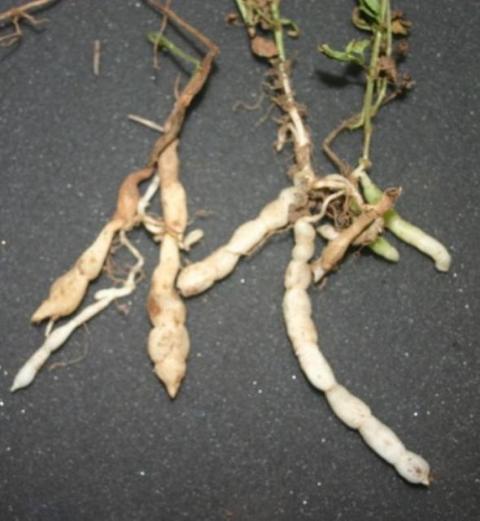
Florida betony weed tubers Photo Credits: UF/IFAS Extension
The tubers make Florida Betony tough to control. Even when above ground foliage and stems are killed due to herbicide use, the tubers allow the regeneration of the plant repeatedly. When attempting to control this weed, it helps to be more persistent than the plant. Many people give up.
Even though it is a perennial, the above-ground portion of the plant grows during fall and spring and becomes dormant during hotter weather.
You can remove the weed by digging, making sure to remove the entire root system (including the tubers). But persistence and patience is required. Herbicide control usually involves repeat applications approved products in lawns. Glyphosate herbicides such as Roundup can be used to control Florida Betony in plant beds. But do not get the herbicide on any green portion of desirable ornamentals.
Always refer to the product’s label for specific uses, application rates and turfgrass tolerance when using any herbicide.
So, why not just dig up the Florida Betony in your lawn and have a native plant feast?
by Larry Williams with content by Matthew Orwat
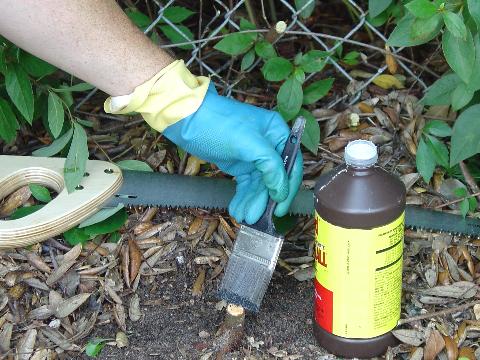
by Larry Williams | Jul 8, 2014
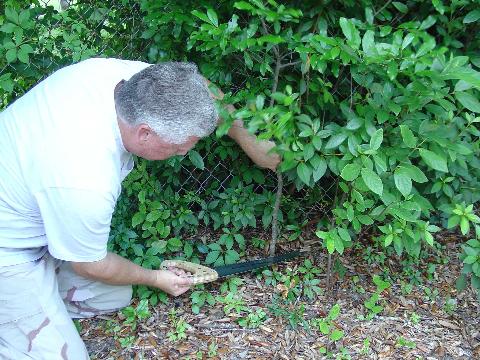
Making cut before herbicide application Photo Credits: Larry Williams & Sheila Dunning, Okaloosa County Extension Agents
Question: We planted Wisteria for its beautiful spring flowers and it grew and grew and took over everything. Now we’re trying to get rid of it. New plants are sprouting everywhere – up to ten feet away from the original plant. Is there a way to rid our landscape of this now wild plant?
Answer: Chinese Wisteria, Wisteria sinensis, can be a big problem to control. I’ve seen entire fields taken over by it. Yet, many people wonder why you would want to kill a beautiful plant like Wisteria. It’s possible to keep it in bounds for a while (possibly years) in the middle of a lawn with its new shoots arising from roots being routinely mowed. But in many cases, given enough time, shoots coming from roots will escape and then begin to take over – growing on adjacent property, climbing trees, etc.

Application of triclopyr herbicide to cut stump Photo Credits: Larry Williams & Sheila Dunning, Okaloosa County Extension Agents
In order to control an established vine, you must be persistent. Your best bet, outside of moving, is to use a “cut stump” treatment on the main plant and every shoot that sprouts. Use a herbicide that contains triclopyr. Some brand names include Enforcer Brush Killer, Ortho Brush-B-Gon, Ferti-lome Brush Killer-Stump Killer. Cut the main stem (trunk) as close to the ground as possible and as level as possible to facilitate application of the herbicide to prevent sprouting. It is critical to immediately apply the product to the freshly cut “stump.” Stumps that are not treated with the herbicide will sprout. Always follow label directions and precautions and be very careful to not get the product on adjacent desirable plants, including their roots.
Other invasive, undesirable woody plants can be controlled using this method such as Chinese tallow (popcorn tree), Chinese privet (Ligustrum sinensis) and Japanese honeysuckle (Lonicera japonica). For more information, view “Herbicide Techniques for Woody Plant Control”, from UF IFAS Extension .
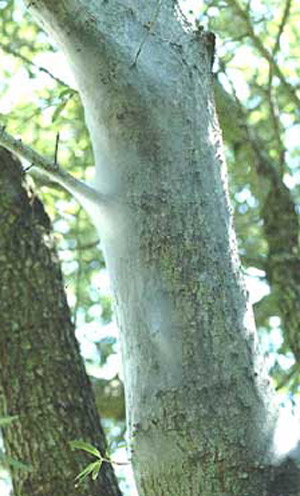
by Larry Williams | Jun 3, 2014

Glistening webbing formed by tree cattle (psocids) Photo credit: Doug Caldwell, University of Florida
Many people are noticing small insects on trunks and branches of their trees. When disturbed, these insects move in a group and are commonly called tree cattle because of this herding habit. They are ¼ inch brownish-black insects with white markings.
Some people assume that these insects will injure their trees but they are harmless. They could be considered beneficial.
These insects are called psocids (pronounced so-cids). They have numerous common names including tree cattle and bark lice. They feed on lichen, moss, algae, fungi, spores, pollen and the remains of other insects found on the tree’s bark. As a result, they are sometimes referred to as bark cleaners.
Tree cattle may form webbing. This webbing is tight against the tree’s trunk and/or limbs. It appears suddenly. The webbing is used as a protection from weather and predators. Underneath you may find psocids.
The glistening webbing may attract a person’s attention resulting in the tree being visually inspected from top to bottom. A dead branch or other imperfections in the tree may be noticed and then wrongly blamed on the tree cattle. I’ve talked to homeowners that sprayed their trees with insecticides or that hired pest control businesses to treat the trees as a result of finding the webbing/psocids. One person told me that he cut down a tree after finding tree cattle. He wrongly assumed that these insects were pests that might move through the area and kill trees. He thought he was doing a good thing.
Adult female psocids lay eggs in clusters on leaves, branches and tree trunks. After hatching, the immature insects (nymphs) remain together under their silk webbing. Adults have wings which are held roof-like over their body. Nymphs are wingless. Psocids usually have several generations per year in Florida.
After seeing the webbing and/or insects, many people insist on spraying insecticides because they believe these insec

Under the webbing live hundreds of psocids. Photo credit: UF/IFAS Jim Castner
ts are damaging their trees. But as mentioned, they are bark cleaners and do not damage trees. If the silk webbing is considered unsightly, a heavy stream of water from a garden hose can be used to wash insects and webbing off infested trees. If nothing is done, the webbing usually goes away in several weeks.
Psocids can be found on many rough-barked hardwood trees and palms. Occasionally, they may be found on wood siding, fence posts or similar areas.
by Larry Williams | Apr 29, 2014

Kentucky bluegrass, Fescuegrass & ryegrass (annual ryegrass pictured) can be seeded to provide a temporary winter lawn but will not provide a permanent lawn in Florida due to our hot, wet summers. Photo Credit: Dan Culbert, UF/IFAS
If it sounds too good to be true, it probably is. This phrase offers sound advice for the person looking for the “perfect” lawn grass.
It’s common to see advertisements for the perfect lawn grass. You should be skeptical when reading advertisements that proclaim an amazing grass that produces a lush, green lawn with very little care. Question advertisements for grass seed mixtures that grow from Alaska to Florida. Beware of advertisements that do not include a specific name for the lawn grass being sold. Don’t believe advertisements that claim their grass even grows in impossible spots.
A number of years ago, I called a company that was advertising a grass seed mixture in hopes of finding out specifically what grass seeds were in this “too-good-to-be-true” mixture. I was told the seed mixture included Kentucky bluegrass, creeping red fescue and annual ryegrass. This information was not included in the advertisement. And it claimed that it would produce an attractive lawn for Florida.
In Florida, ryegrass, fescuegrass and Kentucky bluegrass will produce a green lawn during winter and early spring. However, as temperatures warm in late spring and summer, these grasses will die. All three are cool-season grasses that will not tolerate our hot, humid summer weather. They will not produce a permanent lawn in our area.
Basically there are seven types of grasses from which to choose when considering planting a lawn in Florida. Centipede and St. Augustine are the most commonly planted in our area. Bahia, bermuda, carpet, seashore paspalum and zoysia are used less often. All of these grasses have advantages and disadvantages, which should be looked at and understood before choosing a grass for your lawn.
With time, most people in our area will become frustrated with their lawn. As a result, North Florida is a great area to market a too-good-to-be-true lawn grass. It’s difficult to grow a lawn here. All of our lawn grasses are native to other parts of the world – they did not exist in our native ecosystem. Expectations for a Florida lawn are too high. Because of these factors, many people are looking for that too-good-to-be-true grass.
Be cautious before spending time and money on one of those “perfect” lawn grasses.
Contact the University of Florida Extension Office in your County or visit the following website for reliable information on lawn grass selection and maintenance for Florida. hort.ufl.edu/yourfloridalawn











